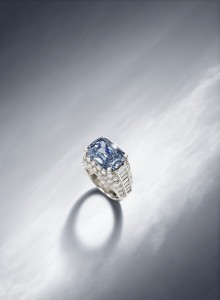Cartier: Style & History Paris Opening
Exhibition organized by the Réunion des musées nationaux - Grand Palais.
Emerald Book at the Galignani bookshop in Paris
Librarie Galignani | 224, rue de Rivoli 75001 Paris
World Record for Blue Diamond Sold at Bonhams London April 24th 2013
A new world record for a Fancy Deep Blue diamond 5.3cts VS2 bought by GRAFF AT BONHAMS
It was one of the best blue diamonds I have seen, there usually is grey in a blue diamond, but this stone was free of any grey colour, in my opinion it should have got a Vivid grading. It had so much life.
The 'Archduke Joseph' Diamond
76.02cts D colour Internally Flawless Type IIA SELLS AT CHRISTIE’S GENEVA NOV 2012 £13,609,559
WORLD AUCTION RECORD FOR A COLOURLESS DIAMOND
Sotheby’s New York Auction April 17th 2013
On April 17, Sotheby’s annual spring auction of Magnificent Jewels takes place in New York, consisting of 400 lots with a combined estimate of more than US$35 million. Led by an exceptional pear-shaped white diamond, the most important diamond ever to come to auction in the Americas, it weighs 74.79ct, is the purest D colour and, most significantly, is potentially internally flawless.
Lot 401, a Cartier “Tutti Frutti” bracelet circa 1930, has an unusual combination of a carved emerald drop, pearl accents and sugar loaf sapphires. It is so rare to find these elements within Cartier’s Tutti Frutti oeuvre that it is possible this one-off piece was a private commission. The stones have an interesting story to tell. In 1911, Jacques Cartier – then head of Cartier London and aged just 27 years – made the first of many trips to India. His first stay corresponded with the Delhi Durbar, where he befriended Maharajas, who were fascinated by Western platinum set jewellery. The opposite was also true, and Jacques, inspired by traditional Indian jewellery, bought carved stones and pearls from Indian dealers and the Maharajas and created jewels such as this bracelet, which were Art Deco in style but with clear Eastern influences. The estimate is US$300,000-$500,000, but similar pieces have realised a lot more – usually around US$800,000-$1,000,000.s. Presented with the original working diagram, which states that the stone may be internally flawless, Lot 387 has been classified a type IIa diamond, which makes up only 2% of the world’s diamonds. If there is a potential for it to be internal flawless, its value will depend on how much weight is lost when re-cutting, but its remarkable size and colour makes it the lot to watch.
Moving on to my personal highlights:
Lot 325 is an exceptional piece. Estimated at US$400,000-$600,000, the circa 1920 emerald and diamond brooch is formerly from the Estate of Sarah Cantine Shrady Gould and Thence by Descent and, amazingly, is not attributed to a particular jeweller. Beyond design and craftsmanship, it is the suggestion of movement that always makes me look twice at a piece of jewellery. The diamond fringes are beautifully articulated, framing that majestic 22.48ct Colombian emerald. Completely free from clarity enhancement, it is an extremely rare example of an emerald of superb natural saturation and transparency.
Lot 323
Lot 323 – a platinum, emerald and diamond ring circa 1930 – and Lot 324 – a platinum, sapphire and diamond ring, circa 1947- are similar in style, with baguette diamonds set either side of the centre stone to best show off those magnificent coloured gemstones. It is noted that the 15.23ct emerald in Lot 323 (estimate US$750,000-$1,000,0000) has insignificant clarity enhancement, which is most likely only a very slight oiling, a process that has been performed since Roman times.
The 31.34ct sapphire ring (estimate US$200,000-$300,000) is signed John Rubel & Co., the workshop that was responsible for some of Van Cleef & Arpels’ earlier pieces, in particular its ballet dancers. Lots 158 and 159 are very interesting because they are by Georges Fouquet and Jean Fouquet, a father and son renowned for moving with the times. Lot 158, a gold, turquoise, diamond and enamel brooch signed G.Fouquet, circa 1925-1930 (estimate $25,000-$35,000), would have been regarded as incredibly avant-garde at the time and still looks incredibly modern today. Lot 159, a gold interchangeable link necklace signed Jean Fouquet, circa 1955-1958 (estimate US$15,000-$20,000), is very collectable too. Jean was part of a movement of jewellers who called themselves “the Modernists” and embraced a geometrical style and juxtaposition of unusual materials. However, this is quite a late piece for Jean and not typical of his audacious style.
I will be watching to see how the market rates Lot 155, a gold, demantoid garnet and diamond ring with an estimate of US$80,000-$120,000. Demantoid garnets are only found in the Ural Mountains in Siberia and are incredibly rare. Recognisable for their horsetail inclusions, they are an amazing, electric green. Usually found in very small quantities and sizes, it is even rarer to find one of this size. 7.66ct is huge, bearing in mind that you normally get a 50% weight loss when cutting gemstones. Finally, there are four beautiful Art Nouveau jewels up for auction, Lots 149, 150, 156 and 157. Only one – Lot 149, a gold, enamel, pink sapphire pearl and diamond pendant, circa 1900 – is by a well-known jeweller of the era, Lucien Gautrait, and it is interesting to see others alongside it in a single auction.













